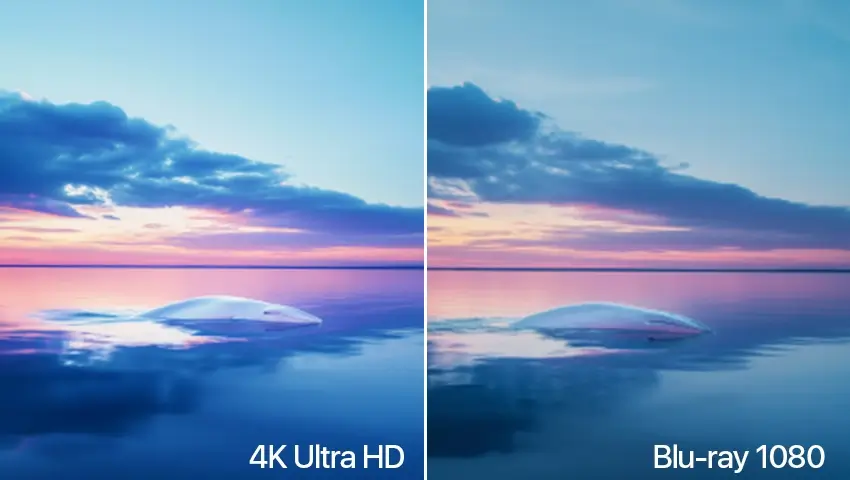The home entertainment landscape has been revolutionized with the advent of high-definition video formats. As we stand on the cusp of a new era in visual fidelity, the debate between Blu-ray and 4K UHD has become a hot topic among cinephiles and tech enthusiasts alike. This blog aims to dissect the intricacies of these two formats, comparing their features, performance, and overall value to determine which one deserves a spot in your entertainment setup.
In the past, the choice was simple: DVD or Blu-ray. Now, with the emergence of 4K UHD, consumers are faced with a new decision. Is it time to upgrade to the latest technology, or does Blu-ray still hold its own? Let’s dive into the details to find out.
Contents
What are the features of 4K and Blu-ray
When it comes to home entertainment, the quality of the viewing experience is paramount. Both Blu-ray and 4K UHD offer high-definition experiences, but they differ in several key areas.
Blu-ray:
Known for its 1080p resolution, Blu-ray offers a significant upgrade over standard DVDs with its high-definition video and lossless audio codecs like Dolby TrueHD and DTS-HD Master Audio. It supports a wide range of video codecs and has a storage capacity of up to 50GB on dual-layer discs. This means that Blu-ray can deliver crisp, clear images and rich, immersive sound that was previously unattainable with standard DVDs.
4K UHD:
4K, or Ultra High Definition, takes resolution to the next level with 3840 x 2160 pixels, offering four times the pixel count of 1080p. Beyond resolution, 4K UHD includes features like HDR (High Dynamic Range), a wider color gamut, and higher color bit depths for a more immersive viewing experience. HDR, in particular, allows for greater contrast and more vibrant colors, making images pop off the screen.
Blu-ray and 4K function comparison
Now that we’ve covered the features, let’s compare these two formats in more detail.
- Resolution: The most obvious difference between Blu-ray and 4K UHD is resolution. 4K UHD’s higher resolution provides sharper images and more detailed content, making it the clear winner in terms of pixel density. This means that every detail, from the texture of a character’s skin to the intricacies of a bustling cityscape, is rendered with stunning clarity.
- Color and Contrast: 4K UHD, especially with HDR, offers a broader color spectrum and better contrast, leading to more vibrant and lifelike images. This is particularly noticeable in scenes with a wide range of lighting, such as outdoor shots at dusk or brightly lit interiors. The increased contrast allows for deeper blacks and brighter whites, enhancing the overall visual experience.
- Audio Quality: While both formats support high-quality audio, 4K UHD often includes object-based audio formats like Dolby Atmos, providing a more immersive sound experience. This means that sound can be placed and moved anywhere in the listener’s environment, creating a more enveloping audio landscape.
- Content Availability: When it comes to the number of titles available, Blu-ray has a more extensive library. However, 4K UHD is quickly catching up with new releases and remastered classics. As more studios adopt 4K UHD for their releases, the gap between the two formats is narrowing.
- Cost and Convenience: Blu-ray discs are generally more affordable than 4K UHD discs, and the players are less expensive. However, 4K streaming services offer a convenient, though not always superior, alternative. Streaming can be a cost-effective way to access 4K content, but it’s important to note that streaming quality can vary depending on internet speed and the specific service used.
FAQs
To further clarify the differences and considerations between Blu-ray and 4K UHD, let’s address some common questions.
1. Is Blu-ray 4K?
Blu-ray discs can be 4K, but most commercial Blu-ray discs are in 1080p resolution. 4K Blu-ray, also known as 4K UHD Blu-ray, is a separate category that offers the higher resolution and additional features of 4K UHD.
2. Is Blu-ray better than 1080p?
In terms of quality, 1080p Blu-ray discs offer higher bitrates and better quality than 1080p regular video due to the higher bitrate. This results in less compression and a clearer, more detailed image.
3. Will there be 8K Blu-ray?
While technically possible, the market demand and practicality of 8K Blu-ray are currently limited due to the need for extremely large screen sizes or very close viewing distances to perceive the difference. As a result, 8K content is more likely to be found in professional and high-end consumer markets for the foreseeable future.
4. Is Blu-ray better quality than Netflix?
The quality can vary, but generally, 4K Netflix videos, due to heavy compression, cannot compare with 1080p Blu-ray discs in terms of quality. However, Netflix and other streaming services are continually improving their compression algorithms to deliver better quality streaming.
Conclusion
In conclusion, while Blu-ray has been the gold standard for home video quality for some time, 4K UHD is rapidly becoming the new benchmark. It offers a superior visual and audio experience, making it the preferred choice for those seeking the best possible home cinema experience. However, the decision between Blu-ray and 4K UHD should also consider factors like content availability, cost, and personal viewing habits. As the market continues to evolve, both formats will likely coexist, catering to different consumer needs and preferences. Whether you’re a die-hard movie buff or just looking to upgrade your home entertainment system, understanding the differences between Blu-ray and 4K UHD will help you make the best choice for your needs.




